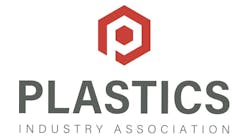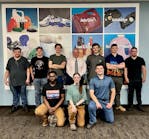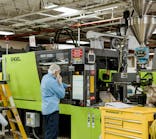Workers that labor in harmony with others and need no breaks. That's the promise of collaborative robots, or cobots, offered by suppliers such as Universal Robots and Fanuc. Along with a new player from Taiwan, these OEMs have introduced technologies and robot accessories for the safe handling of repetitive and strenuous tasks.
UNIVERSAL ROBOTS
In September, Universal Robots introduced its new e-Series cobots, which include a new force/torque sensor, making them ideal for using tools to perform delicate tasks.
The company calls the e-Series its new flagship line.
The e-Series cobots — the UR3e, UR5e and UR10e — include a built-in, tool-centric force/torque sensor that allows them to handle demanding part-finishing tasks such as sanding, buffing, polishing and deburring right out of the box. These operations require accurate torque control to obtain uniform results.
The cobots also are suitable for tending injection molding machines; trimming dies; removing gate vestiges from molded parts; flame treating parts; inspecting parts using visual, ultrasonic and X-ray technologies; in-process labeling; and packing and palletizing boxes.
"The list goes on and on," said Stuart Shepherd, regional sales director for Universal Robots' Americas region. "It's a very versatile product. With this very narrow form factor, it allows it to be tucked into places where other robots might not fit, especially when you add in all the safety curtains and other things that have to go around traditional robots."
The e-Series cobots comply with EN ISO 13849-1 Category 3 PLd and EN ISO 10218-1 standards that allow force- and speed-limited cobots to work side by side with humans, in many cases without the need for additional safety equipment like fencing. As with any robot application, an application risk assessment is recommended to identify any potential hazards requiring additional safety measures, Shepherd said.
"The e-Series strengthens the core principles that define collaborative robots: fast setup, easy programming, flexible deployment, safe operation and a quick ROI," Shepherd said. "As manufacturers increasingly embrace cobots, we see the need to support even more demanding applications with the greater accuracy and tool integration of the e-Series."
The force/torque sensor also can be used to measure mass and ensure a part is within weight specifications.
Repeatability of 30 microns in the UR3e and UR5e models and 50 microns in the UR10e makes the cobots suitable for precise finishing and assembly work, the company said.
The UR3e, the smallest of the three new models, has a payload of 6.6 pounds and a reach of 1.64 feet. With a 360-degree rotation on all wrist joints, the tabletop cobot is suitable for high-precision tasks and light assembly work.
The UR5e has an 11-pound payload and 2.79-foot reach.
The UR10e handles payloads of up to 22 pounds with a 4.27-foot reach. It is capable of tasks like packaging and palletizing.
A new, lightweight, wide-screen teach pendant on the three new models has an intuitive touch screen that reduces programming to a few clicks, according to Universal Robots.
At the same time, advanced operators can use a new, externally accessible 500Hz system bus to implement more complex motion-control algorithms or profiles. The high-speed bus allows for high-speed communications between the cobot and external equipment, such as vision systems.
The user interface includes the ability to program stopping time and distance for protective stops. This feature, not found on other cobots, reduces the complexity and uncertainty involved in performing pre-deployment risk assessments, according to the company.
Because of simplified programming, cobots also can easily be moved and reprogrammed for different tasks.
"Our robots can be moved from machine to machine," Shepherd said. "You don't have to deal with the safety fencing and a lot of the other requirements for traditional robots."
Teaching a cobot new tasks involves moving the robot arm around by hand and using simple programming techniques without the need for complex programming.
"Anybody can do it," Shepherd said. "If you can run a cell phone, you can run a robot."
FANUC
Robot maker Fanuc has rolled out a new series of cobots, along with a new vision sensor that can be used to guide them.
In September, the company introduced its six-axis CR-15iA cobot, a new mid-range option in Fanuc's cobot series that offers payloads from 8.8 pounds to 77 pounds.
The CR-15iA features a 33-pound payload and a 4.7-foot reach. It is available with floor-, ceiling- and angle-mounting options.
Fanuc's CR-15iA includes a sensitive, built-in force sensor that allows it to work safely alongside people in a variety of jobs, including machine tending, inspecting, kitting and warehousing.
Fanuc's cobots provide safety benefits and save floor space, the company said. They can perform strenuous and repetitive tasks without the need for expensive safety barriers typically needed with industrial robots. They are designed to meet the safety requirements of ISO 10218-1:2011.
All of Fanuc's power- and force-limiting cobots are green to distinguish them from standard yellow Fanuc robots.
The CR-15iA includes Fanuc's hand-guidance feature that allows an operator to use a joystick attached to the cobot's arm to move the cobot and program motion paths. It also features easy programming with Fanuc's R-30iB Plus controller's new iHMI (intelligent human-machine interface).
Fanuc's new R-30iB Plus controllers, which come on the CR-15iA, feature the new iPendant with enhanced screen resolution and processing capability. The new iHMI can display guides for setup and programming, as well as tutorials, the company said. Having the tutorials available on the iPendant make setup and operation easy.
Fanuc also introduced its new 3DV/400 Vision Sensor, a lightweight 3-D vision camera that can be mounted in a fixed location or robot-mounted. The sensor has a maximum field of vision of 17.7 inches by 20.8 inches at a distance of 4.27 feet.
Compared to conventional 3-D vision sensors, the 3DV/400 provides better recognition of shiny or translucent parts.
The 3DV/400 is the latest addition to Fanuc's iRVision (integrated robot vision) products, and is available on all Fanuc robots for robot guidance and inspection functions.
In conjunction with a Fanuc robot, the 3DV/400 can perform a variety of functions, including sorting, depalletizing and box handling.
Fanuc robots equipped with the new vision sensor can perform what the company calls 3-D visual line tracking, in which a 3DV/400 mounted overhead finds and tracks parts moving down a conveyor. A robot then picks up parts and separates them into bins. The sensor's speed and accuracy allow it to quickly detect the orientation of a piece.
Fanuc also recently launched its new long-arm M-10iD/10L materials-handling robot.
The M-10iD/10L is a good choice for extracting, picking and placing parts and many other applications in the plastics industry, according to the company.
Compact and fully articulated to reach narrow spaces, the M-10iD/10L provides a solution when space is at a premium, Fanuc said. It can be installed in a variety of positions, including upside down or at an angle.
To prevent snagging and interference, cables and air hoses are routed through the robot's hollow arm, wrist and body. The robot is compatible with Fanuc's latest intelligent technologies, including iRVision and force sensing.
The M-10iD/10L has a maximum load capacity of 22 pounds at the wrist and a reach of 64 inches.
TECHMAN ROBOT
Techman Robot, a Taiwan-based robotics company, is launching sales in the U.S.
Techman, which manufactures cobots with built-in vision systems, has been selling them for about two years in Europe and Asia. It used the International Manufacturing Technology Show, Sept. 10-15, in Chicago, to launch its U.S. sales campaign.
The company is selling three series of cobots — the TM5, TM12 and TM14 series. The TM12 and TM14 series were introduced in September.
The TM5 series includes the TM5-700, which has a 13-pound payload and a 27.5-inch reach, and the TM5-900, with an 8.8-pound payload and a 35.5-inch reach.
Cobots in the TM12 series offer a 26.5-pound payload and a 51-inch reach, while cobots in the TM14 series feature a 31-pound payload and a 43.3-inch reach.
The TM cobots are available in mobile versions that are integrated with automated guided vehicles (AGVs). The mobile versions are compatible with most brands of AGVs and are ideal for stacking and machine-tending applications, the company said. The mobile cobots, with their DC power supply, vision systems and software, can move between two or more locations seamlessly, the company said.
The built-in TM vision system that comes on all the company's cobots offers bar-code and QR-code reading, shape matching, item positioning, image enhancement and color recognition. An easy-to-use interface offers simple programming of the vision system functions, according to the company. The system can be used, among other things, for parts inspection, sorting and ensuring parts are properly oriented and placed, said Ting-Ta Wu, Techman automation engineer.
TMflow, developed by Techman, is the company's robot programming software. The software displays a different image for each robot function and incorporates user-friendly click-and-drag features. The programming makes use of a graphical user interface and can be done on a personal computer, notebook or tablet. Users who have no experience with coding industrial robots can complete a visual pick-and-place program in as little as five minutes, the company said.
The company said another feature that makes its cobots easy to program is the use of servo motors, which simplify hand-guided teaching.
TM cobots comply with ISO 10218-1 and ISO/TS 15066 human-robot cooperation safety requirements, allowing them to be programmed with both speed and force limits, the company said.
Some of the functions that TM cobots can perform are machine tending, gluing, packaging, conveyor tracking, loading, unloading, assembling, testing and quality inspection, according to the company.
TM cobots feature what the company calls its Plug&Play Solution, which allows them to connect to many third-party robotic peripheral products on the market, including gripping systems, industrial cameras and screwdrivers. Each certified TM Plug&Play product has been calibrated and tested by Techman and peripheral equipment vendors to ensure reliable operation.
Techman has more than 50 distributors in Europe and Asia. It is seeking American distributors, but, in the meantime, the company is inviting potential customers to contact its corporate headquarters in Taiwan.
Bruce Geiselman, senior staff reporter
Contact:
Fanuc America Corp., Rochester Hills, Mich., 888-326-8287, www.fanucamerica.com
Techman Robot Inc.,
Taoyuan City, Taiwan, 886-3-328-8350,email [email protected],http://tm-robot.com
Universal Robots USA Inc.,
Ann Arbor, Mich., 844-462-6268,www.universal-robots.com
Bruce Geiselman
Senior Staff Reporter Bruce Geiselman covers extrusion, blow molding, additive manufacturing, automation and end markets including automotive and packaging. He also writes features, including In Other Words and Problem Solved, for Plastics Machinery & Manufacturing, Plastics Recycling and The Journal of Blow Molding. He has extensive experience in daily and magazine journalism.









